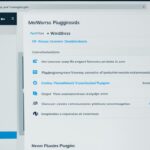Table of Contents
As a WordPress website owner, it is crucial to protect your data from security threats and human errors. Creating regular backups of your WordPress site is an effective way to safeguard your important files, folders, and databases. However, WordPress does not offer a built-in option for automatic backups. In this section, we will explore different methods to backup your WordPress website, including using a plugin, manual backup using cPanel, manual backup of databases, and manual backup using FTP.
Let’s dive into the various methods of backing up your WordPress website to ensure its safety and continuity.
In the following sections, we will explain step-by-step procedures for each backup method, providing you with a comprehensive guide to secure your site.
How to Backup a WordPress Site Using a Plugin (Recommended)
One of the easiest and recommended ways to backup your WordPress site is by using a plugin. The Duplicator Pro plugin is highly recommended as it offers features like scheduled backups, recovery points, cloud storage integration, and migration tools.
To backup your site using the plugin, follow these simple steps:
- Step 1: Install and activate the Duplicator Pro plugin: Begin by installing and activating the Duplicator Pro plugin from the WordPress plugin repository. This can be done by navigating to the “Plugins” section in your WordPress dashboard, clicking on “Add New,” and searching for “Duplicator Pro.” Once found, click on “Install Now” and then “Activate.”
- Step 2: Create a new package: After activating the plugin, access the Duplicator Pro settings from the WordPress dashboard and create a new package. This will initiate the backup process.
- Step 3: Customize your backup settings: In the package creation process, you can customize various backup settings such as file selection, exclusion rules, and database options. Make sure to select the appropriate options to meet your backup requirements.
- Step 4: Perform a scan: Once you have configured your backup settings, perform a scan to analyze your site and identify any potential issues that could affect the backup process.
- Step 5: Build the backup package: After the scan is complete, proceed to build the backup package. This process will create a compressed file containing all your website files, folders, and databases.
- Step 6: Download the backup files: Once the backup package is built, you can download it to your local machine or a secure storage location. This ensures that you have a copy of your website in case you need to restore it in the future.
In addition to manual backups, the Duplicator Pro plugin allows you to schedule automatic backups at regular intervals. This feature ensures that your WordPress site is consistently backed up without any manual intervention.
Furthermore, the plugin enables you to create recovery points, which are specific backup versions that can be used for easy restoration of your website. This functionality is especially useful when testing new plugins, themes, or updates, as it allows you to roll back to a stable state if any issues arise.
With the Duplicator Pro plugin’s comprehensive backup features, you can have peace of mind knowing that your WordPress site is fully protected and easily recoverable in case of any unforeseen events.
“The best way to protect your website is to ensure regular backups and a reliable backup plugin like Duplicator Pro.”
| Benefits of Using Duplicator Pro to Backup Your WordPress Site |
|---|
| Easy installation and activation |
| Scheduled backups for automatic protection |
| Recovery points for easy restoration |
| Integration with cloud storage services |
| Migration tools for effortless website transfers |
How to Backup a WordPress Site Using cPanel
If you prefer a manual approach, you can backup your WordPress site using the cPanel of your hosting service. This method allows you to have a copy of your website files in case of any errors or security issues that may require a complete restoration. Follow these steps to backup your WordPress site using cPanel:
- Log in to your cPanel account using your credentials.
- Locate and click on the “File Manager” icon.
- In the File Manager, navigate to the directory where your WordPress site is installed.
- Select all the files and folders related to your WordPress site. You can do this by using the “Select All” option or manually choosing the files and folders.
- Once all the files and folders are selected, click on the “Compress” option in the File Manager toolbar.
- Choose the compression type (e.g., Zip Archive) and click on the “Compress File(s)” button. This will create a compressed backup file of your WordPress site.
- After the compression process is complete, you will see the backup file in the same directory. Right-click on the backup file and select “Download” to save it to your computer or an external storage device for safekeeping.
Example:
Let’s say your WordPress site is installed in the “public_html” directory. To backup your site, you would navigate to the “public_html” directory in cPanel’s File Manager, select all the files and folders within this directory, compress them into a zip archive, and download the backup file to a secure location.
By manually backing up your WordPress site using cPanel, you have control over the backup process and can ensure that you have a copy of all the necessary files and folders. Remember to regularly perform backups to protect your website and be prepared for any unforeseen circumstances.
| Steps | Description |
|---|---|
| 1 | Log in to your cPanel account using your credentials. |
| 2 | Locate and click on the “File Manager” icon. |
| 3 | In the File Manager, navigate to the directory where your WordPress site is installed. |
| 4 | Select all the files and folders related to your WordPress site. |
| 5 | Click on the “Compress” option in the File Manager toolbar. |
| 6 | Choose the compression type and click on the “Compress File(s)” button. |
| 7 | Right-click on the backup file and select “Download”. |
Now that you have successfully backed up your WordPress site using cPanel, you can rest assured knowing that your files are safely stored and can be easily restored if needed. Regularly perform backups to keep your website data secure and protected.

How to Backup WordPress Databases Manually
In addition to backing up your WordPress files, it is crucial to ensure the backup of your databases for comprehensive data protection. This section will guide you through the process of manually backing up your WordPress databases using phpMyAdmin, an accessible tool within the cPanel of your hosting provider.
To begin the manual backup of your WordPress databases, follow these steps:
- Login to phpMyAdmin: Access the cPanel of your hosting provider and locate the phpMyAdmin option.
- Select the desired database: Once you are in phpMyAdmin, select the database that corresponds to your WordPress site.
- Export the tables: Look for the “Export” tab in phpMyAdmin and click on it.
- Choose the export method and format: Select the appropriate export method for your backup, such as “Quick” or “Custom,” and choose the desired format, typically SQL.
- Save the SQL file: Specify a location on your computer where you want to save the backup file and click on the “Go” or “Execute” button to generate the backup.
By following these steps, you’ll have successfully created a manual backup of your WordPress databases using phpMyAdmin. This backup can be crucial in scenarios where you need to restore your database due to issues that require a rollback or restoration.
Keep in mind that regularly backing up your WordPress databases is essential to maintain the security and integrity of your website’s data.
| Benefits of Manual WordPress Database Backup: |
|---|
| 1. Provides a comprehensive backup solution for your WordPress site. |
| 2. Gives you full control over the backup process. |
| 3. Useful in specific restoration scenarios that require database rollback. |
| 4. Allows you to schedule automated backups for database-only. |
| 5. Ideal for advanced users who prefer a hands-on approach to website management. |
Now that you have learned how to manually backup your WordPress databases, you can ensure the safety of your website’s vital data and have a reliable backup plan in place.
Conclusion
Protecting your WordPress website through regular backups is crucial for safeguarding your data and ensuring website continuity. In this article, we have explored various methods to backup your WordPress site, including using a plugin, manual backups using cPanel and phpMyAdmin, and manual backups using FTP.
When it comes to backup best practices, it is recommended to choose a backup method that suits your needs. WordPress backup plugins such as Duplicator Pro offer convenient features like scheduled backups, recovery points, and cloud storage integration, making them a reliable option for automated backups. Manual backups, on the other hand, using cPanel and phpMyAdmin provide you with more control over the backup process.
To ensure the security of your WordPress site, it is important to establish a regular backup frequency. Regular backups will help mitigate the risk of data loss in case of unforeseen events. By incorporating a backup strategy into your website management routine, you can rest assured knowing that your data is protected.
Remember, backups are your safety net. By considering backup best practices, utilizing WordPress backup plugins, and adhering to a regular backup frequency, you are taking proactive steps to safeguard your WordPress site and protect your valuable data.
FAQ
How can I backup my WordPress website?
There are different methods to backup your WordPress website, including using a plugin, manual backup using cPanel, manual backup of databases, and manual backup using FTP.
What is the recommended method to backup a WordPress site?
The recommended method to backup a WordPress site is by using a plugin, such as Duplicator Pro, which offers features like scheduled backups, recovery points, cloud storage integration, and migration tools.
How do I backup my WordPress site using a plugin?
To backup your WordPress site using a plugin, you need to install and activate a plugin like Duplicator Pro, create a new package, customize your backup settings, perform a scan, build the backup package, and download the backup files. You can also schedule automatic backups and create recovery points for easy restoration.
How can I backup my WordPress site using cPanel?
To backup your WordPress site using cPanel, you need to log in to your cPanel, access the File Manager, select the WordPress site directory, compress the files into a zip archive, and download the backup file to a secure location.
How can I manually backup my WordPress databases?
To manually backup your WordPress databases, you can use phpMyAdmin, which is accessible from the cPanel of your hosting provider. You need to log in to phpMyAdmin, select the desired database, export the tables, choose the export method and format, and save the SQL file as a backup.
Why is it important to backup my WordPress website?
It is crucial to backup your WordPress website to protect your data from security threats and human errors. Regular backups help safeguard your important files, folders, and databases, and allow for easy restoration in case of any issues.
What are the best practices for WordPress website backup?
Some best practices for WordPress website backup include using reliable backup plugins like Duplicator Pro, selecting an appropriate backup frequency, and scheduling regular backups to prevent data loss. It is also important to store backup files in a secure location.












